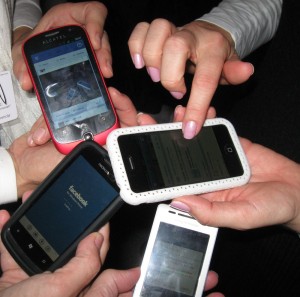Author: Arjana Blazic
ELT Global Issues – Arjana
 Despite living in the second decade of the 21st century, teachers in Croatia still keep talking about adopting new 21st century teaching practices and skills that students should acquire in order to successfully tackle the challenges of the 21st century – as if the 21st century hasn’t arrived yet!
Despite living in the second decade of the 21st century, teachers in Croatia still keep talking about adopting new 21st century teaching practices and skills that students should acquire in order to successfully tackle the challenges of the 21st century – as if the 21st century hasn’t arrived yet!
On the other hand, this clearly indicates that my fellow teachers are aware that the immense changes technology has brought into our everyday lives should be mirrored in our schools as well. No one will deny that we live differently than 10 or 20 years ago: we handle our finances online, we shop online, we play online, we socialize online, we have become learners who use internet resources for learning and so do our students. Technology has radically transformed the way students learn – and as a logical consequence, the way we teach. Or has it?
 Teachers have become lifelong learners who want to keep abreast of the latest developments in 21st century education and are more than willing to change their practices accordingly. Most of the teachers in my country pursue their professional development at conferences, seminars and workshops organized by the Ministry of Education and other educational agencies.
Teachers have become lifelong learners who want to keep abreast of the latest developments in 21st century education and are more than willing to change their practices accordingly. Most of the teachers in my country pursue their professional development at conferences, seminars and workshops organized by the Ministry of Education and other educational agencies.
Even though the Ministry introduced computer literacy training as an integral part of teacher education programs in the form of ECDL courses (European Computer Driving License) back in 2005, most professional development courses offered to teachers are still more related to the 20th century. However, there are a lot of teachers who acquire new skills, competences and knowledge as self-learners through personal learning networks that they have built on various social networking sites. Most importantly, they are willing to share the knowledge they gain with their colleagues who don’t actively participate in this type of learning. In this way, the circle of teachers who want to inspire, motivate and empower their students with the help of new technologies considerably grows.
However, after becoming ready to get to grips with new technologies, teachers are faced with another obstacle – poorly equipped schools. School funding has never been on a very high level, unfortunately, and with the recent economic crisis which is still a menace in Croatia, even less money is invested in schools.
Let me take my school to show you what this means. I teach at a high school that comprises about 500 students, aged between 15-19, and 44 teachers. The number of computers provided at school is rather small compared to the number of students. We have two computer labs, one with 10 and the other with 16 computers, purchased almost 10 years ago, so you can image what it looks like to work on these old machines. Nevertheless, the labs are used all the time – in fact, with so many enthusiastic computer literate teachers, every week there’s a mad scramble for the two labs. We have a sign-up list in the staffroom, run by the ICT teacher on the first come first serve basis. While I can boast a collegial atmosphere in my staffroom, when it comes to the matters of computers, the situation changes drastically. Sometimes there is so much animosity between the parties involved, that it seems unlikely they’ll ever be reconciled. Luckily, there’s always the next week’s list and the thrill of computer-assisted teaching that is not likely to disappear.
If we don’t need Internet access and can do with only one computer in class, we can avail ourselves of one of the three laptops and beamers. This is often done by teachers, but rather reluctantly because we have to carry this entire load from classroom to classroom as the teachers are those who move, while students remain stationary in their classrooms. The reason for not having our own labs is that we share the premises with another school. Because the school building is too small to hold 1000 students at the same time, we work in shifts – and this is something we would definitely like to change as soon as possible.
A two-shift system means that one week we are at school in the morning from 8 am till 2pm, whereas the afternoon shift from 2 pm till 8 pm (!) is taken by the other school. The next week it’s the other way round. This is not an exception here in Croatia; it’s rather a rule, unfortunately. Hopefully, all schools will have moved to one shift system by 2020.
Because of scarce equipment, many teachers, me included, have wholeheartedly embraced BYOD: Bring your own device. As a huge supporter of BYOD, I strongly believe that students should be taught that the powerful devices they bring to school every day shouldn’t be a distraction from learning but a means to enhance learning. When I first told my students that they were going to use their mobile devices for learning, they were shocked. They never expected their teacher to teach with mobile phones, because more often than not teachers confiscate their devices! However, I was also taken aback upon seeing that only half of their phones were smart devices. Another problem was that only few students had access to the internet on their devices and as we have no wireless network at school, we couldn’t do much. But still, I gave it a try, divided them in groups and it worked! Not exactly as I had planned or hoped for, but still – it was a good beginning that showed potential.
As Sir Ken Robinson said, “If you are not prepared to be wrong, you’ll never come up with anything original!” Nor will you be able to fight the obstacles and become a 21st century teacher! (Yes, yes, I know that the 21st century is in full swing, but you know what I mean!)


